Chicago Bee: Cornerstone of the Black Metropolis

At State and 36th on the South Side is an Art Deco structure that stands as a beautiful icon of Bronzeville and Chicago’s Black Metropolis. Now a public library and reading room, it was built by entrepreneur Anthony Overton to house the Chicago Bee.
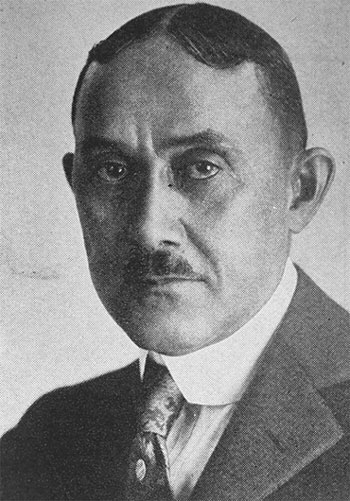
Anthony Overton, image courtesy of wttw
Anthony Overton, Pillar of African-American Enterprise
The founder of the Chicago Bee, Anthony Overton, was a successful entrepreneur who shaped much of Bronzeville and the South Side in the early 1900s.
Despite challenges of race and class, he went on to great achievement earning a law degree, serving as a municipal judge, and later founding the Overton Hygienic Company in Kansas City, Missouri, which manufactured and sold baking powder, flavored extracts, and toiletries.
With a move to Chicago in 1911, Overton expanded his facilities and increased his product line to more than 100 cosmetics, which were distributed internationally. Later, reaching for new markets, Overton became the first black cosmetics maker to place products in Woolworth drug stores.
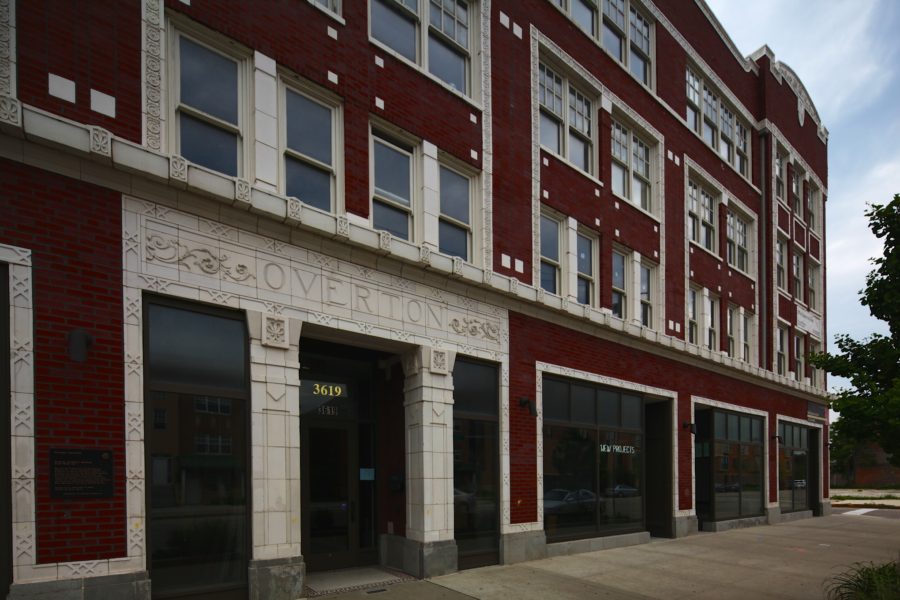
Overton Hygienic Building, a block away from the Bee building. John Morris/Chicago Patterns
In addition to the Chicago Bee and the Hygienic Manufacturing Company, Overton also founded Douglass National Bank, Victory Life Insurance, and Great Northern Realty Company. He was the first African-American to lead a major business conglomerate.

1929 deed for Chicago Bee building, on display in the Bee Branch library
Rise of the Chicago Bee and Black Metropolis
Overton’s entrepreneurial efforts spawned commerce, jobs, and architecture for the near South Side. Many of his commercial ventures were at the intersection of 35th and State, the heart of Black Metropolis.
The other name for the area is Bronzeville, first used by Chicago Bee editor James Gentry. It was a reference to the skin color of newly arriving African-Americans from the South.
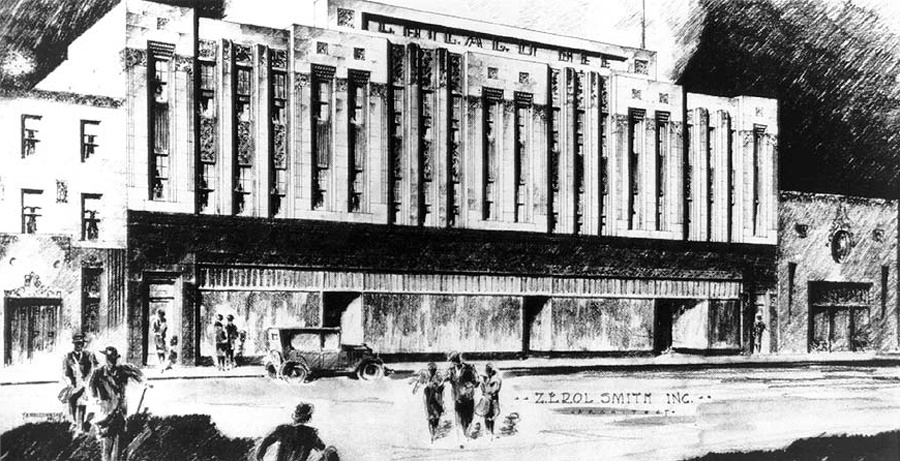
Architectural drawing of Chicago Bee building by Z. Erol Smith. Note “Chicago Bee” inscription on top of front facade. Image courtesy of National Park Service
The Chicago Bee was founded in 1926, and three years later Overton hired South Side architect Z. Erol Smith to design a building for the operation. The structure was erected at a cost of $200,000, and would later house his other business ventures, including Overton Hygienic.

November 1929 cover of Chicago Bee, on display inside the Chicago Public Library – Bee Branch
Overton stated that the Bee would dedicate itself to “higher education for all groups, cordial relations between the races, civic and racial improvement, the promotion of Negro business, and good, wholesome and authentic news fit for any member of the family.”
A 1929 advertisement further illustrates the guiding principles of the publication:
WHAT THE BEE STANDS FOR
The suppression of superstition–with enlightenment. Higher education for all groups. Cordial relations between races. Civic and racial improvement and development. The promotion of Negro business. Good, wholesome and authentic news, fit for any member of the family.
WHAT THE BEE DOES NOT STAND FOR
The Chicago Sunday Bee will not play up any plan or perpetrate upon its readers and the public any scheme, ostensibly for the public benefit, when at the same time the prime object of such plan or scheme is to gain paid advertisers for this paper, or in any way or matter ulterior in its aspect.
The Chicago Sunday Bee will not accept fraudulent advertisements: Advertisements dealing with oil well schemes, wild-cat securities, lucky stones, voodooism, or any advertisements that tend to ridicule the Negro or exploit the Public.
The Chicago Sunday Bee will not print any front page headlines in red.
The Chicago Sunday Bee denies any man the right to become prominent by committing a crime.
It was staffed entirely by women for most of its existence between 1926 to 1946.

1985 photo of Chicago Bee building. Image courtesy of National Park Service
Decline of the Chicago Bee and Black Metropolis
The Bee building was planned and designed at the height of the 1920s boom, and building completion coincided with the stock market crash that would adversely affect commerce in Chicago and across the nation.
A 1993 Chicago Reader article describes the hardships that came as a result of the economic downturn:
The Depression took its toll on all of Black Metropolis; many of Overton’s businesses collapsed alongside those that surrounded him. The neighborhood’s clubs began to cater to a crowd of gangsters and gamblers. The center of black business moved south to 47th and South Parkway (now Martin Luther King Jr. Drive). Jesse Binga’s bank closed in 1930, and Binga later served time for embezzlement. The Douglass National Bank closed its doors and Overton dissolved the Victory Life Insurance Company in 1932. As soon as the Chicago Bee Building was completed in 1931, Overton moved his cosmetics business there and was forced to sell the Overton Hygienic Building. He did manage to keep the Bee running until his death in 1946, and the Overton Hygienic Manufacturing Company stayed in business through the early 80s.
–Adam Langer
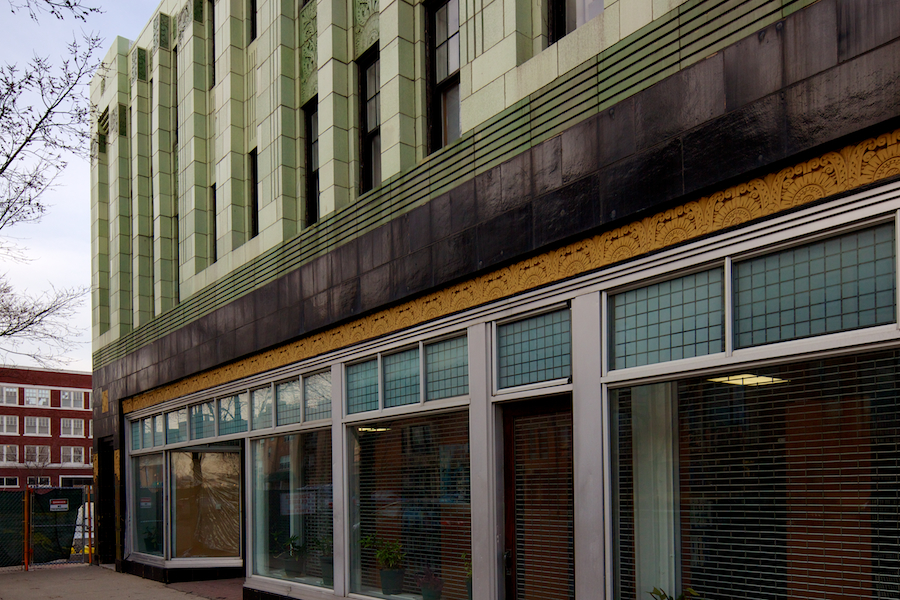
John Morris/Chicago Patterns
New Life for the Bee Building
While many of the elegant and elaborate structures of Black Metropolis were razed in the 1960s and 1970s, the Bee Building and neighboring Overton Hygienic Building–whose business later moved into the Bee Building–survived. The Hygienic manufacturing business folded in the 1980s.
The Bee Building sat vacant for the next several years until 1996, when it underwent an extensive renovation to become the Chicago Bee branch of the Chicago Public Library.
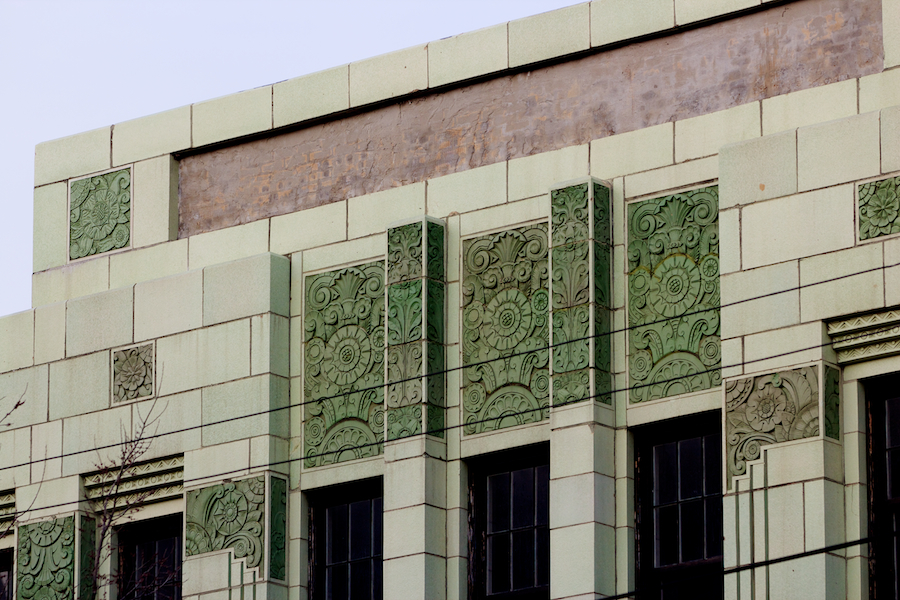
John Morris/Chicago Patterns
Art Deco Marvel
The exterior terra cotta was created by the Northwestern Terra Cotta Company of Chicago. The company had a number of French artisans who learned Art Deco forms after working on the 1925 Internationale des Arts Decoratifs et Industriels Modernes.
The facade is remarkably intact, featuring logarithmic spirals, nautilus forms, and organic shapes representing growth and life. Sadly, the terra cotta with the Chicago Bee inscription is no longer present.

John Morris/Chicago Patterns
The Bee Branch Library features a number of reference items on local history and African-American history. This library branch is easily accessible via the 35th-Bronzeville-IIT Green Line station and is an important cultural icon, so check it out.
References and Further Reading
- Black Metropolis (Chicago Reader)
- Riots to Renaissance: Overton’s beauty products (wttw)
- Chicago’s Black Metropolis and surrounding area, 1920s (National Park Service)
- Nomination form for National Register (PDF, National Park Service)
- Black Metropolis – Bronzeville (PDF, City of Chicago)
Related Articles
- Chicago Jazz History Revealed at Meyers Ace Hardware
- 43rd Street Bronzeville Walking Tour, Part 3: The Forum
- 43rd Street Bronzeville Walking Tour, Part 2: ‘Doctor Dan’
- Illinois Service Federal: Architecture from the Atomic Age


What a fascinating piece of history. I’ve never heard of Anthony Overton. However I do remember my Great Aunt mentioning The Chicago Bee.
Also to see Overton’s Beauty Supply store in the photo. It’s a reminder that African Americans did used to have thriving businesses in the hair care supply industry in the city.
This was really good John!
Thank you Andi! I had a lot of fun researching it, and the folks at the Bee Branch library were very helpful in helping me locate historic information.
We worked collaboratively to save the historic Chicago Bee building from demolition in the 1990’s. Still, have pictures in the Bronzeville Visitor Information Center archives of the public demonstrations